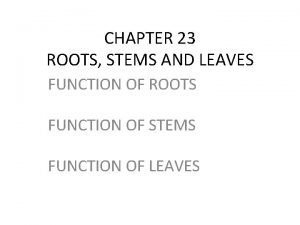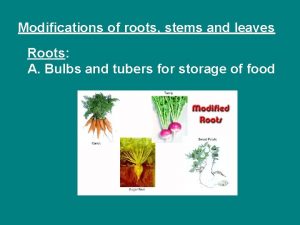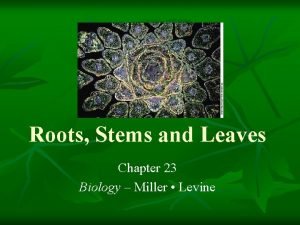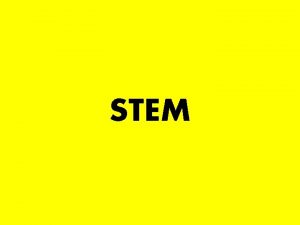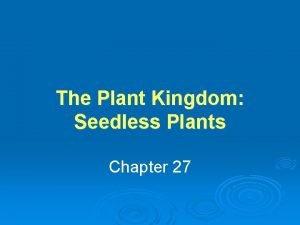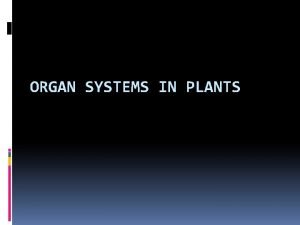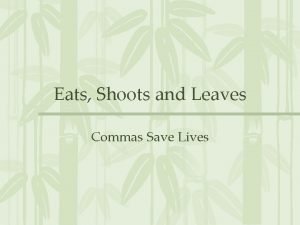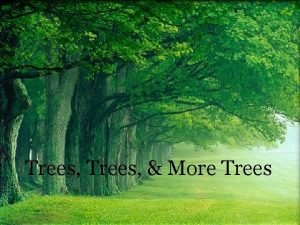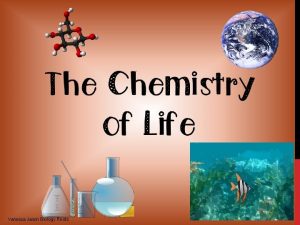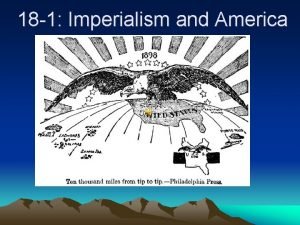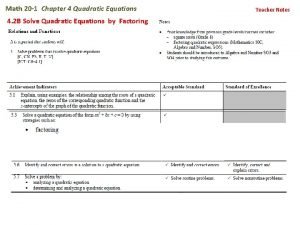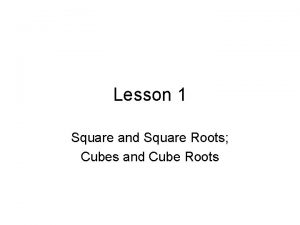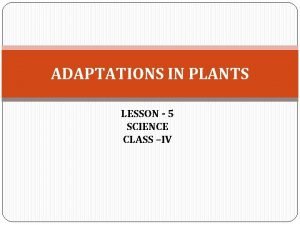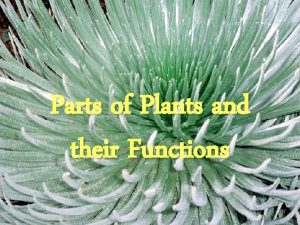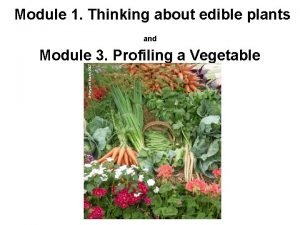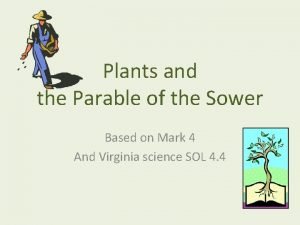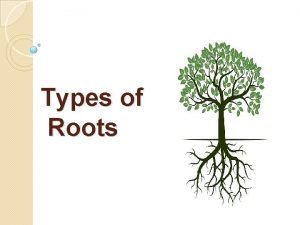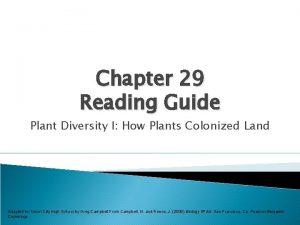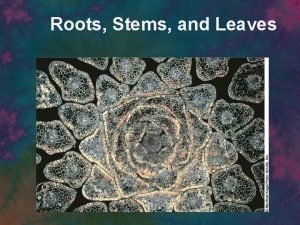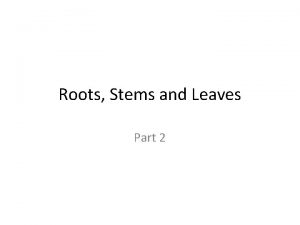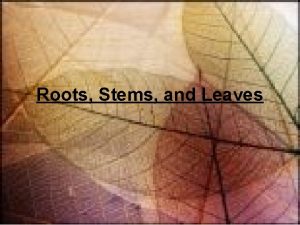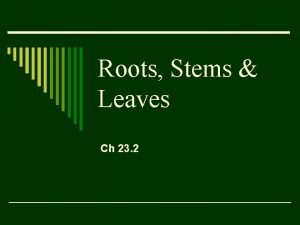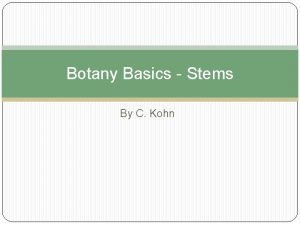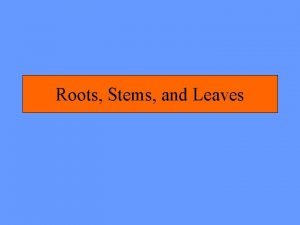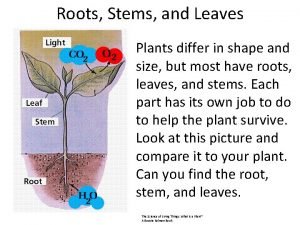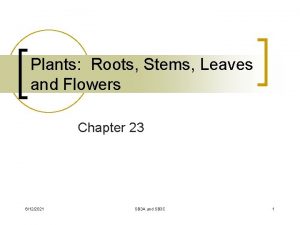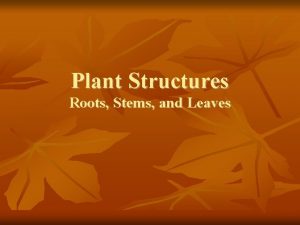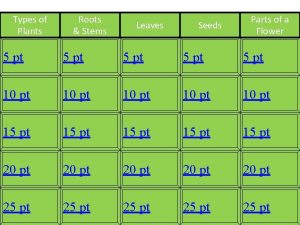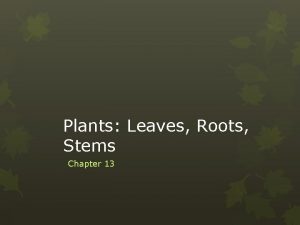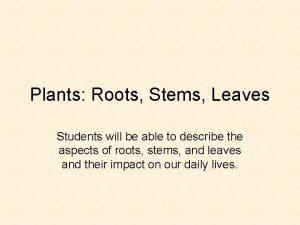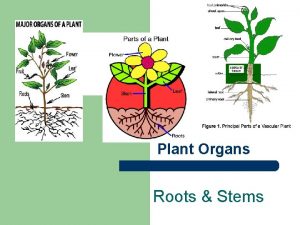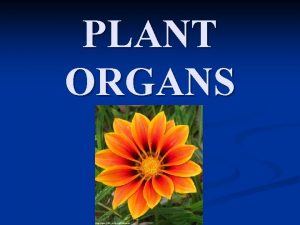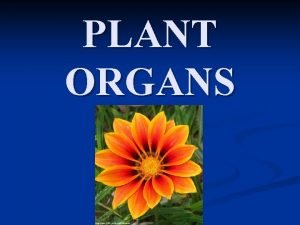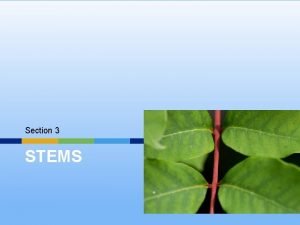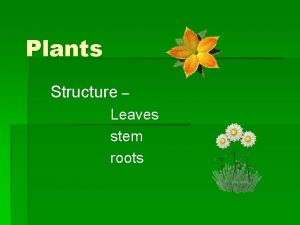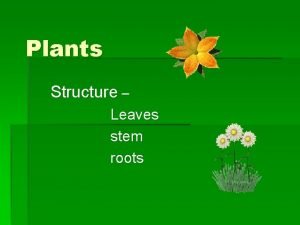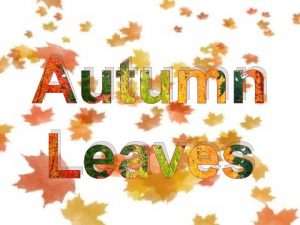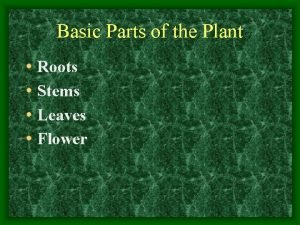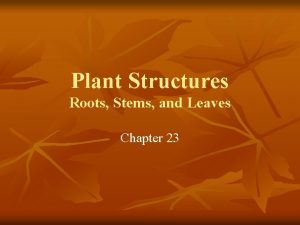ROOTS LEAVES STEMS A Plants have 3 organs


























- Slides: 26

ROOTS, LEAVES, & STEMS

A. Plants have 3 organs: 1. Roots Anchor Absorb water and nutrients 2. Leaves Photosynthesis 3. Stems Support and transport

B. Plant Organs are made of 3 Plant Tissues: Dermal Tissue- Epidermal cells Outer covering or “skin” of the plant Vascular Tissue- Xylem & Phloem Transport of water, nutrients, and sugars Ground Tissue- Cortex Fills up the space between the vascular and dermal tissues

Plant Organs are made of 3 Plant Tissues: Dermal Tissue Ex. Cuticle, Trichomes, & Root hairs

Plant Organs are made of 3 Plant Tissues: Vascular Tissue (two types) a. Xylem- transports water up b. Phloem- transports sugar to parts that do not photosynthesize

Xylem Phloem


Plant Organs are made of 3 Plant Tissues: Ground Tissue-Fills up the space between the vascular and dermal tissues a. Parenchyma- thin cell walls, in leaves for photosynethesis b. Collenchyma- thick cell walls, strong and flexible for support, ex. Strings of celery c. Sclerenchyma- extremely thick cell walls, vey strong for support, ex. Grit in pears a. b. c.

C. Plants grow at Meristems- clusters of undifferentiated cells Plants are made of merismatic tissue This tissue undergoes differentiationbecome different cells Found at the tips of roots and buds, are apical meristems This allows the plant to continue growing in length above and below ground, primary growth

Primary Growth vs. Secondary Growth

ROOTS There are 2 types of roots: 1. Taproot (dicots)- one long, thick primary root ex. Carrot 2. Fibrous root (monocots)- many small thin roots bundled together ex. Grasses

B. Root Structure & Growth 1. Root Cap- very tip of the root, protects root as it grows 2. Root Hairs- tiny projections from the epidermis 3. Cortex- layer of ground tissue 4. Vascular cambium- center of root with vascular tissues

C. Root Function Anchor the plant to the ground Absorb water and nutrients from the soil Casparian strip- surrounds each endodermis cell and doesn’t allow backflow of water creating root pressure and moving water by osmosis through the xylem tissue Without this pressure plants would wilt

LEAF: General Structure Blade- thin flattened section used to catch light, main part of the leaf A. Simple- one blade per petiole B. Compound- many leaflets per petiole Petiole- piece of leaf that connects to the stem

B. Leaf Function 1. Photosynthesis- occurs in mesophyll cells 2. Gas Exchange- movement of CO 2 & O 2 in and out 3. Transpiration- loss of water through a plants leaves 90% of water that enters a plant is lost due to transpiration

Leaf Function: Photosynthesis- occurs in mesophyll cells a. Palisade mesophyll- tall, columnar cells, tightly packed b. Spongy mesophyll- loose cells with many air spaces c. Vein- vascular tissues to move water & sugars through

Leaf Function: Gas Exchange- movement of CO 2 & O 2 in and out a. Guard cells- cells that control opening and closing of stomata b. Stomata- pores that allow gases into spaces, spongy mesophyll

Leaf Function: Transpiration- loss of water through a plants leaves (90%) Process is possible because of waters 2 properties: 1. Cohesion- molecules of the same kind tend to stick together 2. Adhesion- attraction between unlike molecules

Cohesion & Adhesion

STEMS: Structure 1. Node- where leaves attach 2. Internode- regions between nodes 3. Bud- location near nodes, produces new stems & leaves Lateral bud- give rise to branches Terminal bud- apical meristem

Stem Function 1. Produce- leaves and branches 2. Hold- leaves up into the sunlight 3. Transport- substances between roots and leaves a. Water pulled through xylem up from roots ○ Root pressure- no back flow ○ Capillary action- adhesion of water to tubes ○ Transpiration- loss of water through leaves b. Sugars pushed through phloem ○ Pressure-flow hypothesis- water moves food from high concentration to low

Lenticels

Stem Growth 1. Primary growth- length of stems a. end of roots and shoots at apical meristems 2. Secondary growth- width/thickness of stems a. Vascular cambium- merismatic tissue in between xylem and phloem that produces new vascular tissue b. Cork Cambium- produces outer covering of stems (cork) c. Wood- layers of xylem ○ 1. Heartwood- old, no longer conducts water ○ 2. Sapwood- younger, still conducts water d. Bark- phloem, cork cambium, and cork; breaks off as stem gets thicker



 Section 23-2 roots answer key
Section 23-2 roots answer key Modifications of roots
Modifications of roots What are the functions of stems
What are the functions of stems What is herbaceous stem
What is herbaceous stem What part of the plant carries and protects the seed
What part of the plant carries and protects the seed Flocabulary photosynthesis read and respond answers
Flocabulary photosynthesis read and respond answers Liverwort life cycle
Liverwort life cycle Organs working together
Organs working together Panda eats shoots and leaves joke
Panda eats shoots and leaves joke Leaves branches trunk and roots song
Leaves branches trunk and roots song Chonp
Chonp Square roots and cube roots guided notes
Square roots and cube roots guided notes Existence and uniqueness of square roots and cube roots
Existence and uniqueness of square roots and cube roots Economic roots of american imperialism
Economic roots of american imperialism Quadratic equation
Quadratic equation Opposite of squaring
Opposite of squaring Function of leaves in plants
Function of leaves in plants Adaptation in plants class 7
Adaptation in plants class 7 Parts of a flower objectives
Parts of a flower objectives Leaves we eat as vegetables
Leaves we eat as vegetables Plants
Plants Types of roots
Types of roots Gametophytes have gamete-producing organs called _____.
Gametophytes have gamete-producing organs called _____. Vascular plants
Vascular plants Vascular plants vs nonvascular plants
Vascular plants vs nonvascular plants Classification of non flowering plants
Classification of non flowering plants C3 plants vs c4 plants
C3 plants vs c4 plants
